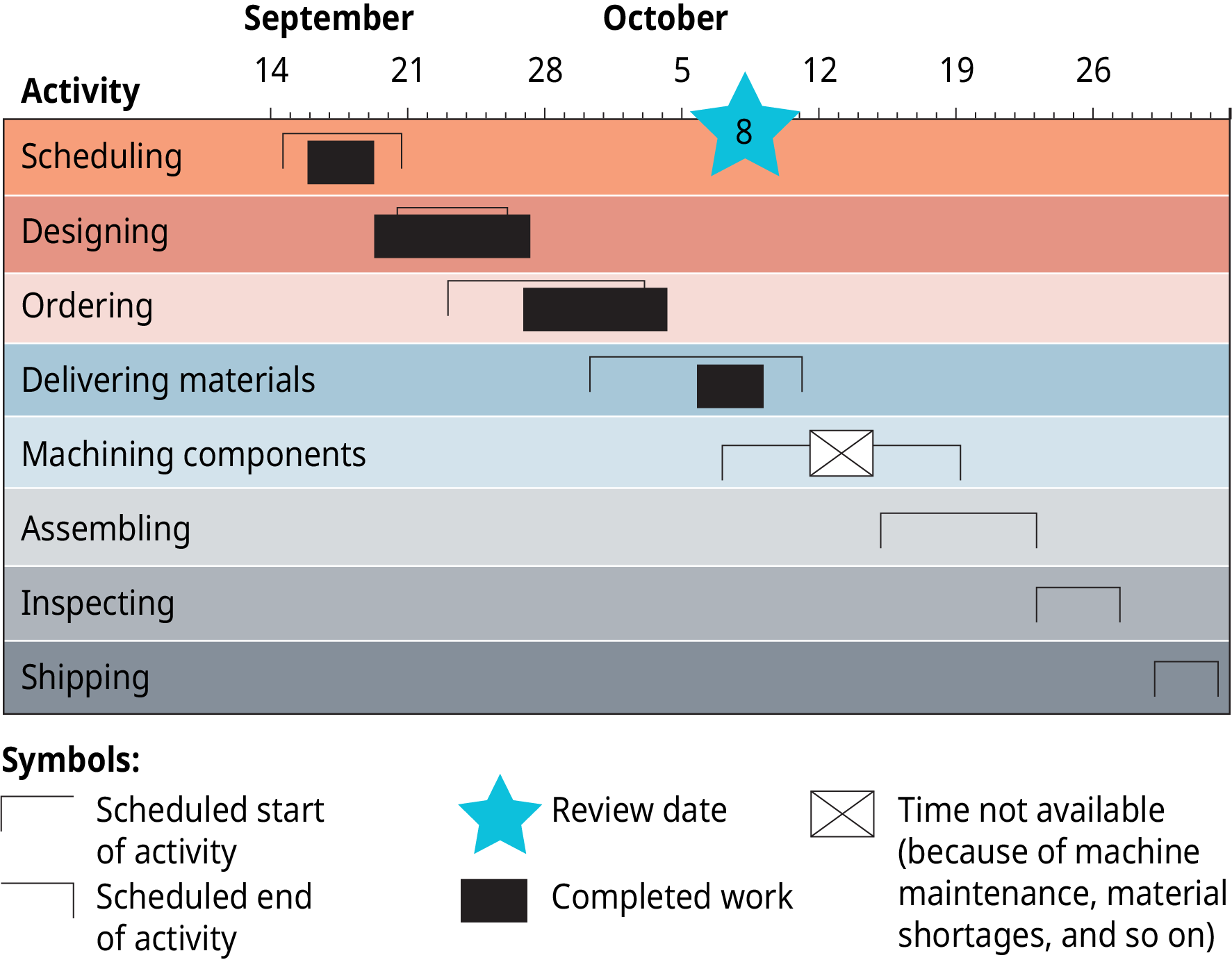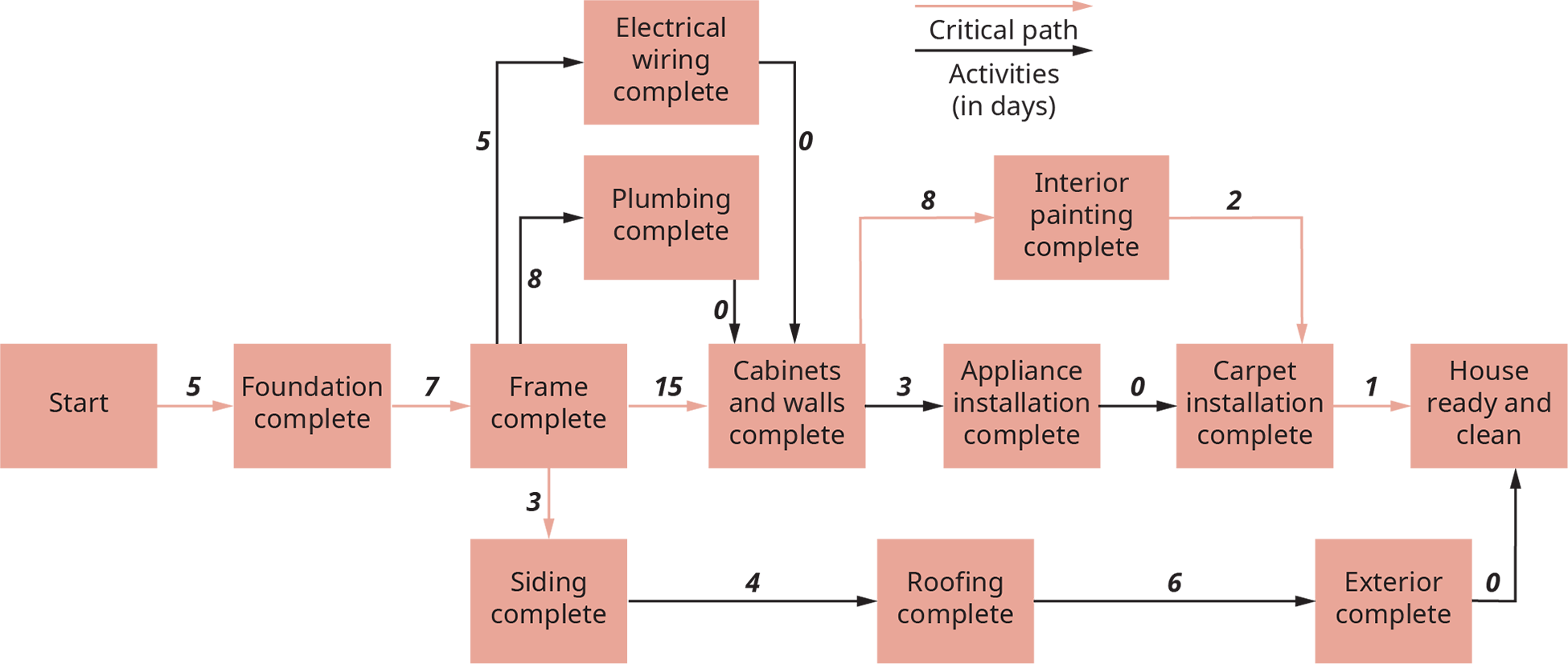31 Production and Operations Control
OpenStax
- How do operations managers schedule and control production?
Every company needs to have systems in place to see that production and operations are carried out as planned and to correct errors when they are not. The coordination of materials, equipment, and human resources to achieve production and operating efficiencies is called production control. Two of its key aspects are routing and scheduling.
Routing: Where to Next?
Routingis the first step in production control. It sets out a work flow, the sequence of machines and operations through which a product or service progresses from start to finish. Routing depends on the type of goods being produced and the facility layout. Good routing procedures increase productivity and cut unnecessary costs.
One useful tool for routing is value-stream mapping, whereby production managers “map” the flow from suppliers through the factory to customers. Simple icons represent the materials and information needed at various points in the flow. Value-stream mapping can help identify where bottlenecks may occur in the production process and is a valuable tool for visualizing how to improve production routing.
Awning manufacturer Rader Awning & Upholsteryused value-stream mapping to automate some of its operations. With the assistance of New Mexico Manufacturing Extension Partnership(MEP), the company evaluated how orders were processed from sales to manufacturing over two days. With the implementation of the processes suggested by MEP, productivity improved by 20 percent per salesperson, production defects decreased by 15 percent, and installation corrections dropped by 25 percent.
Scheduling: When Do We Do It?
Closely related to routing is scheduling. Schedulinginvolves specifying and controlling the time required for each step in the production process. The operations manager prepares timetables showing the most efficient sequence of production and then tries to ensure that the necessary materials and labor are in the right place at the right time.
Scheduling is important to both manufacturing and service firms. The production manager in a factory schedules material deliveries, work shifts, and production processes. Trucking companies schedule drivers, clerks, truck maintenance, and repairs in accordance with customer transportation needs. Scheduling at a college entails deciding when to offer which courses, in which classrooms, with which instructors. A museum must schedule special exhibits, ship works to be displayed, market its offerings, and conduct educational programs and tours. Scheduling can range from simple to complex. Giving numbers to customers waiting to be served in a bakery and making interview appointments with job applicants are examples of simple scheduling. Organizations that must produce large quantities of products or services or service a diverse customer base face more complex scheduling problems.
Three common scheduling tools used for complex situations are Gantt charts, the critical path method, and PERT.
Tracking Progress with Gantt Charts
Named after their originator, Henry Gantt, Gantt chartsare bar graphs plotted on a time line that show the relationship between scheduled and actual production.
In the example shown in (Figure), the left side of the chart lists the activities required to complete the job or project. Both the scheduled time and the actual time required for each activity are shown, so the manager can easily judge progress.
Gantt charts are most helpful when only a few tasks are involved, when task times are relatively long (days or weeks rather than hours), and when job routes are short and simple. One of the biggest shortcomings of Gantt charts is that they are static. They also fail to show how tasks are related. These problems can be solved, however, by using two other scheduling techniques, the critical path method and PERT.
The Big Picture: Critical Path Method and PERT
To control large projects, operations managers need to closely monitor resources, costs, quality, and budgets. They also must be able to see the “big picture”—the interrelationships of the many different tasks necessary to complete the project. Finally, they must be able to revise scheduling and divert resources quickly if any tasks fall behind schedule. The critical path method (CPM) and the program evaluation and review technique (PERT) are related project management tools that were developed in the 1950s to help managers accomplish this.
In the critical path method (CPM), the manager identifies all of the activities required to complete the project, the relationships between these activities, and the order in which they need to be completed. Then, the manager develops a diagram that uses arrows to show how the tasks are dependent on each other. The longest path through these linked activities is called the critical path. If the tasks on the critical path are not completed on time, the entire project will fall behind schedule.
To better understand how CPM works, look at (Figure), which shows a CPM diagram for constructing a house. All of the tasks required to finish the house and an estimated time for each have been identified. The arrows indicate the links between the various steps and their required sequence. As you can see, most of the jobs to be done can’t be started until the house’s foundation and frame are completed. It will take five days to finish the foundation and another seven days to erect the house frame. The activities linked by brown arrows form the critical path for this project. It tells us that the fastest possible time the house can be built is 38 days, the total time needed for all of the critical path tasks. The noncritical path jobs, those connected with black arrows, can be delayed a bit or done early. Short delays in installing appliances or roofing won’t delay construction of the house because these activities don’t lie on the critical path.


Like CPM, the program evaluation and review technique (PERT)helps managers identify critical tasks and assess how delays in certain activities will affect operations or production. In both methods, managers use diagrams to see how operations and production will flow. PERT differs from CPM in one important respect. CPM assumes that the amount of time needed to finish a task is known with certainty; therefore, the CPM diagram shows only one number for the time needed to complete each activity. In contrast, PERT assigns three time estimates for each activity: an optimistic time for completion, the most probable time, and a pessimistic time. These estimates allow managers to anticipate delays and potential problems and schedule accordingly.
- What is production control, and what are its key aspects?
- How can value-stream mapping improve routing efficiency?
- Identify and describe three commonly used scheduling tools.
Summary of Learning Outcomes
- How do operations managers schedule and control production?
Routing is the first step in scheduling and controlling production. Routing analyzes the steps needed in production and sets out a workflow, the sequence of machines and operations through which a product or service progresses from start to finish. Good routing increases productivity and can eliminate unnecessary cost. Scheduling involves specifying and controlling the time and resources required for each step in the production process. Operations managers use three methods to schedule production: Gantt charts, the critical path method, and PERT.
Glossary
- critical path
- In a critical path method network, the longest path through the linked activities.
- critical path method (CPM)
- A scheduling tool that enables a manager to determine the critical path of activities for a project—the activities that will cause the entire project to fall behind schedule if they are not completed on time.
- Gantt charts
- Bar graphs plotted on a time line that show the relationship between scheduled and actual production.
- program evaluation and review technique (PERT)
- A scheduling tool that is similar to the CPM method but assigns three time estimates for each activity (optimistic, most probable, and pessimistic); allows managers to anticipate delays and potential problems and schedule accordingly.
- routing
- The aspect of production control that involves setting out the work flow—the sequence of machines and operations through which the product or service progresses from start to finish.
- scheduling
- The aspect of production control that involves specifying and controlling the time required for each step in the production process.
- value-stream mapping
- Routing technique that uses simple icons to visually represent the flow of materials and information from suppliers through the factory to customers.
Download for free at http://cnx.org/contents/c3acb2ab-7d5c-45ad-b3cd-e59673fedd4e@8.80

